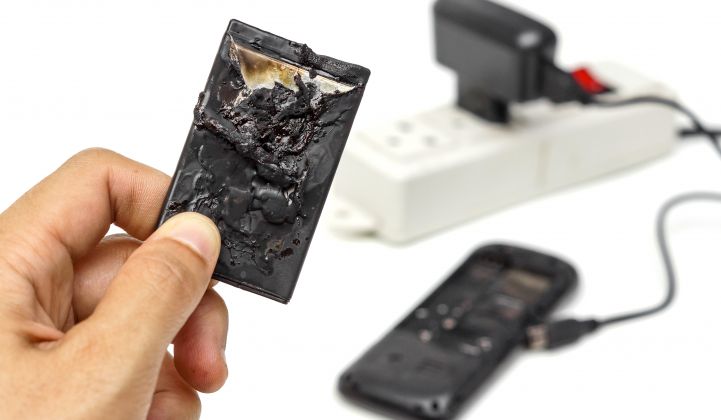If you’re going to have lithium-ion grid batteries catching on fire, it might as well be in a state-of-the-art battery testing facility. Not only is it the kind of thing you’re supposed to catch before installing systems in the field, it’s an opportunity for the industry to get some good data on energy storage safety.
S&C Electric Company has released a report on last month’s big fire at its Franklin, Wisc. testing facility, one that provides a deep level of detail on how it started -- in the battery manufacturer’s DC power and control compartment, not the batteries themselves -- and how it was contained and put out.
Nobody was hurt, no significant structural damage was reported, and the batteries themselves didn’t explode -- although it took an initial application of alcohol-resistant aqueous film-forming foam (AR-AFFF), and a subsequent 500 gallons-per-minute water bath for a few hours, to cool them down below danger levels.
All told, it was a pretty good outcome for what could have been a life-threatening event, informed by some important rules that S&C follows in designing, assembling and operating its energy storage systems.
“We kind of learned a lot of this stuff over the last 10+ years we’ve been doing this,” Tim Qualheim, S&C’s senior vice president of applied grid solutions, said in an interview last week. “Battery manufacturers know their batteries really well.” But they don’t necessarily have the same expertise in battery and power conversion system equipment or controls, or the electrical switching and protection devices like fuses, circuit breakers and relays that are part of S&C’s core business.
The batteries in the room weren’t charging or discharging when last month's fire started, but they were burning and smoking by the time the fire department had arrived. “The reality is that lithium-ion batteries are very energy-dense, and once they start releasing their energy, the priority is controlling the pace at which they release that energy,” the report noted. Cutting power to the building was the first precautionary step, as was sharing Material Safety Data Sheets on the batteries involved, to give first responders what they needed to know about the fire they were getting ready to fight.
Fire suppression systems and the containers themselves are also important factors, he said. On that note, the DC power and control that started last month’s fire was part of a larger storage system being assembled at the time. That means the doors of the system, which would normally be closed during operations, were open for the safety of the people putting it together, and the fire suppression system was not fully functional -- things that wouldn't happen in a “field-deployed” energy storage system.
Expertise in any single component that makes up a grid-tied lithium-ion battery also needs to be matched by system design expertise, Qualheim noted. That involves basic concepts like “having a system that physically separates the various components, the batteries from the inverters, for example,” he said. On the electrical side, the Franklin facility is typically assembling about a dozen systems at a time and each one goes through a “whole series of tests ranging from normal system operation to backup and fail-safe system operations.”
One of the big challenges S&C identified in its report is sharing data on how to fight battery fires when they do happen. On that front, the company is working with the National Fire Protection Association, which has identified lithium-ion batteries in electric vehicles, and potentially in behind-the-meter building applications, as a concern.
The dangers of lithium-ion batteries experiencing thermal runaway are fairly well known, and have led to airline groundings, major recalls of cellphones, and intense scrutiny paid to the handful of fires in electric vehicles from Tesla Motors. The New York Fire Department has been particularly active on the lithium-ion safety issue, leading a set of industry workshops on how to manage behind-the-meter storage systems in the event of fires.
Despite this, the biggest grid battery fires and explosions have been at facilities using other chemistries, such as Xtreme Power’s lead-acid chemistry in the 2012 fire at the Kahuku wind farm on Hawaii’s Oahu north shore, and NGK’s sodium-sulfur systems in a 2011 fire in Japan.



